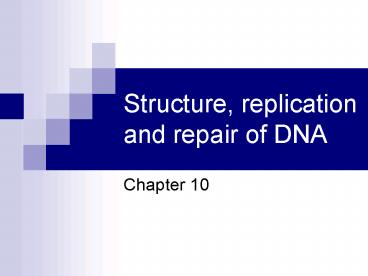Structure, replication and repair of DNA - PowerPoint PPT Presentation
Title:
Structure, replication and repair of DNA
Description:
Structure, replication and repair of DNA Chapter 10 On Feb. 28, 1953 Watson and Crick discovered the structure of DNA Nearly beaten to the discovery by Rosalind ... – PowerPoint PPT presentation
Number of Views:89
Avg rating:3.0/5.0
Title: Structure, replication and repair of DNA
1
Structure, replication and repair of DNA
- Chapter 10
2
- On Feb. 28, 1953 Watson and Crick discovered the
structure of DNA - Nearly beaten to the discovery by Rosalind
Franklin (she would have won if she had not been
socially isolated) - Chemical make up had been known for 30 years, but
not the three-dimensional structure, which would
give a clue as to how it worked. - Nucleotides - sugar-phosphate backbone and
nitrogenous bases.
3
Nucleotides monomers for DNA
4
Phosphate Sugar (deoxyribose)
5
Chargaffs Rules
The amount of A amount of T The amount of C
amount of G This is because A and T are
always paired together on opposite strands (so
are G C).
6
DNA is a double helix A helix is a twisted
molecule. DNA is two helices held together by
hydrogen bonds.
7
DNA strands have a directionality, like a pencil,
and they run in opposite directions antiparallel.
8
Review of directionality in DNA
New bases always add on to the 3 end of the
molecule
9
Bases held together by H bonds G-C held w/ 3 A-T
held w/ 2
The two DNA strands twist around an imaginary
axis that runs up the center of the molecule.
10
DNA and information flow
- Central Dogma
- Genetic information is encoded into the structure
of the DNA molecule - To use this information, DNA is copied into RNA
(transcription), and the RNA is used to direct
proteins synthesis (translation). - For a cell to reproduce, the DNA molecule has to
be copied DNA replication.
11
Semiconservative replication
Each new DNA molecule is made of one old strand
and one new one.
12
- There are one or more spots on a DNA molecule
where replication always begins. - These are called origins of replication.
- The most studied DNA belongs to a bacterium
called Escherichia coli.
13
Prokaryotic DNA has one origin where replication
starts. Eukaryotic DNA has multiple origins.
Bacterial DNA
14
- Replication forks are the areas where the DNA
unzips and is copied. - Joining small molecules (like nucleotides)
together to make large molecules is called
polymerization, and the large molecules are
polymers. - DNA polymerase enzyme that joins nucleotides
- DNA always replicates by adding to the 3 end.
15
Correct complementary base is added to new
growing DNA strand.
16
- DNA polymerase needs something to add the
nucleotides to. - A primase copies short pieces of DNA as RNA
primer. - DNA polymerase then joins DNA nucleotides to the
primer. - When it meets the primer, it replaces it with
DNA. - The ends are joined by an enzyme called DNA
ligase.
17
-
- A T G C T C G A C T A G C A A C G T A G
- T A C G A G C T G A T C G T T G C A T C
5
3
5
3
3
5
3
5
In answer to a question a piece of DNA is
flipped.
18
Mutations
- A mutation is a permanent, inheritable change in
the DNA. - To be passed on to the next generation, this
mutation must be present in the gametes (eggs or
sperm). - Mutagens are factors that speed up the rate of
mutation formation - Certain chemicals, radiation
19
Types of mutations
- Chromosomal mutations large sections of
chromosomes are altered - Point mutations one to a few base changes Point
mutations can be - Base substitutions
- Insertions
- Deletions
20
- Chromosomal mutations can be
- deficiencies deletions of many nucleotides
- Translocations sections of DNA moved to another
chromosome - Inversions a section of DNA turned upside down
- Duplications large sections appear twice
- Aneuploidy
http//users.rcn.com/jkimball.ma.ultranet/BiologyP
ages/T/Translocation_8-14.gif
translocation
21
Review of how aneuploidy occurs
22
- THEDOGSAWTHECAT
- THEDOGSAWTHYCAT
- THEDOGSAWTHECOT
- THEDOGSAWTHECAT
- A
- THEDOGASAWTHECAT
- THE DOG ASA WTH ECA T
- THEDOGSAWTHECAT
- THO GSA WTH ECA T
- THEDOHOWAREYOUGSAWTHECAT
23
Trivia about mutations
- Mutations are rare
- There are some hot spots, but any particular
gene has about a 1 in 10 million chance of
mutating. - Mutations are generally harmful
- Genes that work the best have evolved, so usually
a change is either neutral or harmful.
24
Why dont we see more mutations?
- Silent mutations can occur in non-coding (junk
) DNA. - If we change the last codon, in many cases we get
the same amino acid. - We have pairs of chromosomes, so a good gene may
cover for a bad one. - We have about 50 enzymes that police our DNA
looking for changes and fixing them.
25
(No Transcript)
26
Factors that cause mutations
- Naturally occurring
- Radiation
- Chemicals
- Viruses































